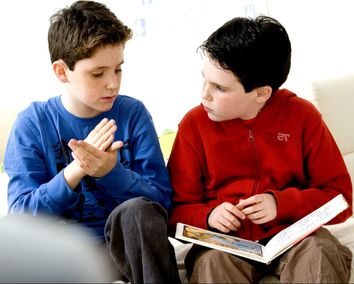Cultural Influences on Language
|
Page 5 |
As with any language, the culture impacts the language.
ASL is no different. The way we think and view the world around us, is directly linked to our language. Cultural norms influence language and vice versa. These also differ per language and culture. For example, a common term used in France is “ma petite puce” which translates in English to “my little flea.” Parents often use this as a term of endearment towards their young daughters, but it sounds harsh and maybe even insulting in English. This is due to the cultural differences between the two countries.
|
In American Sign Language, there are similar characteristics. Typically, these pertain to the use of the signs and the facial expressions that accompany them. There are also certain signs that apply specifically to the intent of the sign. For example, there are 2 different signs for “love.” One applies to the emotional love which is signed as an embrace with a loving face, while the other refers to the love, or favoritism of an object or place. Combined with these signs are facial expressions that are specific and intentional.
|
Deaf individuals also find it acceptable to tap on the shoulder of a person with whom they are attempting to speak with. You may also see Deaf people stomping or waving their hands to get a person’s attention. In Hearing communities, this is not regular behavior, but that is due to differences in cultural norms. It is incredibly important to respect these cultures and to strive to understand and honor their values, beliefs, and traditions.
Interpreters
Hearing people often see ASL interpreters during events such as press conferences, concerts, sporting events, and more. These interpreters have a very important job to do. They are taking the spoken information and translating it into American Sign Language. Doing so is a complex and heavy undertaking which relies on the person’s ability to accurately translate the spoken information.
Adaptations
Though Deaf individuals do not see their lack of hearing as a disability, there are certain adaptations that many utilize in their daily lives. These adaptations make subtle changes to typical objects and routines that hearing people are accustomed to. Some examples include the use of flashing lights to alert a person of a doorbell ringing, or an alarm going off. Video conferencing technology is used so that communication is visible as opposed to auditory. Many Deaf people use text messaging as much as possible, as well.
Deaf Society
For well over one hundred years, the Deaf community in America has strived to create a culture and subculture that they identify with and are extremely proud of. While some people view deafness as a disability, Deaf individuals do not! They take pride in their deafness, similar to some ethnic groups. Through the years the Deaf community has created churches, educational institutions, professional circles, scholarly, dramatic, and athletic organizations, just to name a few.
Deaf culture typically includes deaf members of the community, but also extends willingly to children of deaf parents and interpreters in the community, as well as educators and professionals. These community members are all valued and play a role in society.
Deaf culture typically includes deaf members of the community, but also extends willingly to children of deaf parents and interpreters in the community, as well as educators and professionals. These community members are all valued and play a role in society.
Values, Behaviors, and Traditions
As with any culture there are values, behaviors, and traditions that play a very important role in daily life. Some of these include:
- Support for bilingual deaf children
- Promoting independence for deaf community members
- Supporting an environment that relies on vision as the primary sense used
- Valuing deaf children and their quality education
- Inclusion of rules of interaction within the community such as maintaining eye contact during a conversation, etc.
- It is acceptable to sign with your mouth full, but is not acceptable to sign with your hands full
- Much of the communication that is shared comes from facial expressions, which warrants the need for staring when communicating. This is completely acceptable
- Deaf individuals place high value on face-to-face interactions and appreciate the time that a person puts in to an exchange



